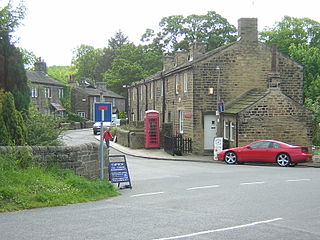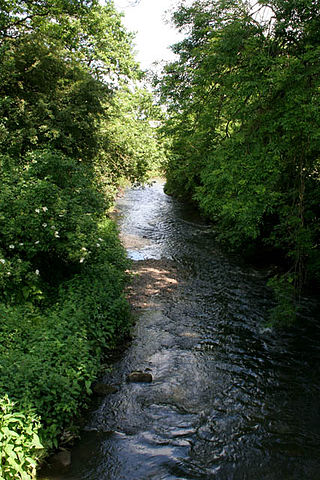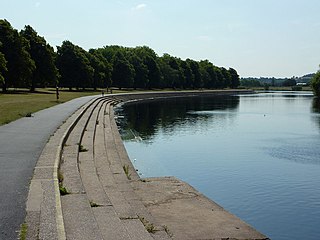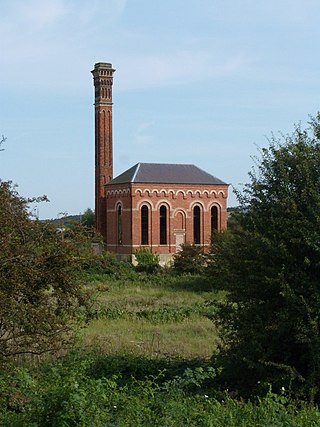History
There is no substantial evidence of occupation during early periods, but some artifacts have been found. In 1951, a Neolithic stone axehead was found in a field between the sewage treatment works and the river, while a late Bronze Age spearhead was found in the River Trent in 1928 when the channel was being dredged. It was 10.8 inches (275 mm) long, and is now at the Nottingham Castle Museum. There is some evidence of a Romano-British field system in the area, although this has been identified by aerial photography, and of the ten sites identified, none have been investigated on the ground. There is also evidence of an Iron Age promontory camp, with a bank and ditch to the east and a bank to the west. Some Roman finds probably indicate that it was occupied during the Roman period.
Before the Norman conquest of Britain, the manor of Gedling was in the kingdom of Mercia, and was held by Thegn Otta and then passed to his son Tochi. Following the conquest, the manor was given to William Peveril, and some land passed to the Bardolph family as a result of marriage during the reign of Henry II. They built a fortified manor house or moated castle near to the ferry crossing to Shelford. Evidence from the street plan of the village and the layout of the adjacent fields shows that it was established during the Medieval period. White's Directory of Nottinghamshire, published in 1853, recorded that an ancient chapel had once existed within the village, but that no trace of it then remained.
The Bardolph family were connected with the area until the late 15th century.
"The Bardolphs, who will ever remain linked by name to the county through the village of Stoke Bardolph on the banks of the silvery Trent—the Bardolphs, who once occupied a prominent place in the front ranks of English nobility, as all readers of Shakespeare's 'Henry IV.' will well remember."
"Joan Bardolph, eldest daughter of Thomas Bardolph, was Lady Bardolph, and had a daughter, Elizabeth, who married John, Viscount Beaumont, by whom she had a son, William, Viscount Beaumont and Lord Bardolph, who was attainted by Parliament 4 November 1 Ed. IV. (1461). His sister, Jane, thus became heir and married John, Lord Lovell; their son, Francis, was killed fighting against the king at the battle of Stoke-field, 16 June 1487."
Their moated house near the river was used to hold the Court Baron, which managed disputes related to the feudal system, and the Court Leet, which dealt with local legal matters, until at least 1539. In the port-medieval period, the village was agricultural. Common land was divided up by an enclosure Act obtained in 1798. By 1872, the village had a population of 174, living in 38 houses, and also had a post office, a chapel of ease, and a ferry. It was described as a township within the parish of Gedling.
Sewage farm
By the 1870s, the lower parts of Nottingham were regularly affected by flooding of polluted water from the River Leen, as a consequence of six parishes adjacent to the town discharging raw sewage into the river. Marriott Ogle Tarbotton had become the Borough Engineer for Nottingham in 1859, and the Nottingham and District Sewerage Act 1872 enabled the Nottingham and Leen District Sewerage Board to be created. Tarbotton became the Sewerage Board engineer, in addition to his other duties, and set about building sewers and sewage pumping stations to convey effluent from the city to Stoke Bardolph. The Nottingham Borough Extension Act 1877 (40 & 41 Vict. c. xxxi) enabled the offending parishes to be incorporated into Nottingham, and the borough to take over the responsibilities of the sewerage board. [11]
The corporation leased 638 acres (258 ha) of agricultural land from Earl Manvers at first. [11] A deed from 1878 states that John Elliot Burnside leased the farm, now known as Stoke Farm, to the Mayor, Alderman and Burgesses of the Borough of Nottingham for a period of 60 years, at an annual rent of £135. It was situated immediately to the north of the church building, [13] and was known to have good drainage, allowing the sewage to be spread over the land, where it seeped into the soil. The farm was subsequently purchased. Tarbotton was responsible for the construction of the sewage farm, and the first stage became operational on 17 June 1880. However, he did not see it completed, as he suffered a stroke while attending a meeting of the Sewage Farm Committee on 4 March 1887, and died two days later. Additional land adjacent to the original site was acquired, some of which was in the neighbouring parish of Bulcote. The farm produced milk from cattle kept on the land, and was also a centre for pedigree shire horses and pigs. [11]
Plans for a new sewage treatment works were drawn up in 1928, to be situated further to the west. Work on a combined scheme for main drainage and sewage disposal works began in 1936. New piping was constructed, and a new pumping station at Sneinton was commissioned, to bring additional sewage to the farm. New buildings housed preliminary treatment facilities, before the effluent was spread on the land. During the 1950s, the works were extended to include secondary treatment, by the addition of an activated sludge plant and final settlement tanks. In 1974, responsibility for the plant was transferred from the City of Nottingham to Severn Trent Water Authority, one of ten regional water authorities established under the terms of the Water Act 1973 to manage water resources in England and Wales.
By the early 2010s, the site was the second-largest managed by Severn Trent Water, serving around 500,000 domestic customers, and the equivalent of another 200,000 due to discharges from trade customers. It was also treating waste from a local animal rendering plant, which entered the works separately. The secondary treatment facilities were reaching the end of their working life, and as a result of the Urban Waste Water Treatment Directive, the levels of phosphorus in the final effluent needed to be reduced. A conventional solution would have involved extensive reconstruction of the facilities and the addition of another activated sludge plant, but a more innovative approach was taken, which enabled much of the existing infrastructure to be reused, and the size of the activated sludge plant to be reduced. This was achieved by ammonia and phosphorus removal before the liquor entered the activated sludge plant. Removal of these substances has another beneficial effect, as it significantly reduces blockages in pipes due to the precipitation of struvite, or magnesium ammonium phosphate. The solution adopted produces half a tonne of phosphorus per day, and was £19.2 million cheaper than the cost of a conventional solution. Operational costs are also £165,000 per year lower.
The process of using anaerobic digestion to treat sewage sludge has been used on Severn Trent sites since the 1950s, and Stoke Bardolph works uses a biomethane plant to turn the gas produced by the digestion process into biomethane. This is then supplied to the national gas network. The plant runs continuously, and produces around 500 cubic metres (18,000 cu ft) of biomethane per hour from 1,000 cubic metres (35,000 cu ft) of biogas. The gas is washed, compressed and an odour is added to it before it is pumped into the gas network. In 2017, the site was partially self-sufficient, producing some 38 percent of its energy needs in this way, and Severn Trent hope to increase this to 50 percent by 2020.

Esholt is a village and former civil parish in the metropolitan district of the City of Bradford, West Yorkshire, England. It is situated 3 miles (4.8 km) east of Shipley town centre, 1.5 miles (2.4 km) south-west of the A65 in Guiseley, 7 miles (11 km) north of Bradford City Centre, and 10 miles (16 km) north-west of Millennium Square, Leeds.

Gedling is a local government district with borough status in Nottinghamshire, England. The council is based in Arnold. The borough also includes Carlton along with villages and rural areas to the north-east of Nottingham. The main built-up part of the borough around Arnold and Carlton forms part of the Nottingham Urban Area.

Arnold is a market town in the Borough of Gedling in the county of Nottinghamshire in the East Midlands of England. It is situated to the north-east of Nottingham's city boundary. Arnold has the largest town centre in the Borough of Gedling and the most important town centre in the northeastern part of the conurbation of Greater Nottingham. Gedling Borough Council is headquartered in Arnold. Since 1968 Arnold has had a market, and the town used to have numerous factories associated with the hosiery industry. Nottinghamshire Police have been headquartered in Arnold since 1979. At the time of the 2011 United Kingdom census, Arnold had a population of 37,768.

The River Erewash is a river in England, a tributary of the River Trent that flows roughly southwards through Derbyshire and Nottinghamshire, forming the boundary between the two counties for much of its length. It rises near Kirkby-in-Ashfield, and passes close to Pinxton, Ironville, Langley Mill, Eastwood, Ilkeston, Trowell, Stapleford, Sandiacre, Toton and Long Eaton to reach the River Trent near Beeston.

Rushcliffe is a constituency in Nottinghamshire represented in the House of Commons of the UK Parliament from 2024 by James Naish, a Labour MP.

Gedling is a constituency in Nottinghamshire created in 1983 represented in the House of Commons of the UK Parliament since 2024 by Michael Payne of the Labour Party. The seat was safely Conservative until the Labour Party's landslide victory in 1997, when it was won for Labour by Vernon Coaker. Labour held Gedling until 2019, when it was regained by the Conservative Party, but regained the seat in 2024.

Milorganite is a brand of biosolids fertilizer produced by treating sewage sludge by the Milwaukee Metropolitan Sewerage District. The term is a portmanteau of the term Milwaukee Organic Nitrogen. The sewer system of the District collects municipal wastewater from the Milwaukee metropolitan area. After settling, wastewater is treated with microbes to break down organic matter at the Jones Island Water Reclamation Facility in Milwaukee, Wisconsin. The byproduct sewage sludge is produced. This is heat-dried with hot air in the range of 900–1,200 °F (482–649 °C), which heats the sewage sludge to at least 176 °F (80 °C) to kill pathogens. The material is then pelletized and marketed throughout the United States under the name Milorganite. The result is recycling of the nitrogen and phosphorus from the waste-stream as fertilizer. The treated wastewater is discharged to Lake Michigan.

Colwick is a village and civil parish, in the Borough of Gedling of Nottinghamshire, England. It is situated to the east of Nottingham's city boundary, and forms the Colwick ward. At the time of the 2011 census, the village had a population of 2,829, falling to 2,778 at the 2021 census.

Basford was a rural district close to Nottingham, England, from 1894 to 1974. The district consisted of two detached parts, to the north and south of Nottingham. It was created under the Local Government Act 1894 based on the existing Basford rural sanitary district.

Thurgarton was a wapentake of the historic county of Nottinghamshire, England. It extended north-eastwards from Nottingham. The River Trent formed most of the eastern boundary. It consisted of the parishes of Averham, Bathley, Bleasby, Blidworth, Bulcote, Burton Joyce, Calverton, Carlton, Carlton-on-Trent, Caunton, Caythorpe, Colwick, Cromwell, East Stoke, Edingley, Epperstone, Farnsfield, Fiskerton, Fiskerton cum Morton, Fledborough, Gedling, Gonalston, Grassthorpe, Gunthorpe, Halam, Halloughton, Haywood Oaks, Hockerton, Holme, Hoveringham, Kelham, Kersall, Kirklington, Kneesall, Lambley, Lindhurst, Lowdham, Maplebeck, Marnham, Meering, Morton, Normanton on Trent, North Muskham, Norwell, Norwell Woodhouse, Nottingham St Mary, Ossington, Oxton, Park Leys, Rolleston, Sneinton, South Muskham, Southwell, Staythorpe, Stoke Bardolph, Sutton on Trent, Thurgarton, Upton, Weston, Winkburn and Woodborough.

Gedling is a village and former civil parish which gives its name to the larger Borough of Gedling in Nottinghamshire, England. It lies 4 miles (6.4 km) north-east of Nottingham city centre. The parish was abolished in 1935 and absorbed into the urban district of Carlton, which in turn was abolished in 1974 on the creation of borough of Gedling. The population of the Gedling ward at the 2011 census was 6,817 and 111,787 for the district. Gedling was recorded in the Domesday Book and is still a distinct settlement, although residential, commercial and industrial growth in the wider borough of Gedling and the neighbouring city of Nottingham, boroughs of Broxtowe and Rushcliffe and district of Ashfield means it can be difficult to distinguish the village of Gedling from the nearby town of Carlton, with which it has become contiguous.

Minworth is a village situated in the civil parish of Sutton Coldfield, West Midlands, within Minworth there are three hamlets Wiggins Hill, Peddimore and The Greaves. Minworth lies within the City of Birmingham district on its northeastern outer fringe, where it forms part of the Sutton Walmley and Minworth electoral ward and borders the North Warwickshire district, some 4.5 miles southeast of Sutton Coldfield town centre.

Netherfield is a town in the Borough of Gedling in Nottinghamshire, England. It is situated to the east of Nottingham's city boundary and is approximately 3 miles (4.8 km) between Colwick and Carlton in the NG4 postcode area, and near the River Trent. The appropriate Gedling ward was called 'Netherfield and Colwick' until boundary reorganisation in 2015, when it became 'Netherfield', with 'Colwick' becoming a separate ward.. At the time of the 2011 census, the population of this ward was 7,398.

Sewage sludge treatment describes the processes used to manage and dispose of sewage sludge produced during sewage treatment. Sludge treatment is focused on reducing sludge weight and volume to reduce transportation and disposal costs, and on reducing potential health risks of disposal options. Water removal is the primary means of weight and volume reduction, while pathogen destruction is frequently accomplished through heating during thermophilic digestion, composting, or incineration. The choice of a sludge treatment method depends on the volume of sludge generated, and comparison of treatment costs required for available disposal options. Air-drying and composting may be attractive to rural communities, while limited land availability may make aerobic digestion and mechanical dewatering preferable for cities, and economies of scale may encourage energy recovery alternatives in metropolitan areas.

Sewage treatment is a type of wastewater treatment which aims to remove contaminants from sewage to produce an effluent that is suitable to discharge to the surrounding environment or an intended reuse application, thereby preventing water pollution from raw sewage discharges. Sewage contains wastewater from households and businesses and possibly pre-treated industrial wastewater. There are a high number of sewage treatment processes to choose from. These can range from decentralized systems to large centralized systems involving a network of pipes and pump stations which convey the sewage to a treatment plant. For cities that have a combined sewer, the sewers will also carry urban runoff (stormwater) to the sewage treatment plant. Sewage treatment often involves two main stages, called primary and secondary treatment, while advanced treatment also incorporates a tertiary treatment stage with polishing processes and nutrient removal. Secondary treatment can reduce organic matter from sewage, using aerobic or anaerobic biological processes. A so-called quarternary treatment step can also be added for the removal of organic micropollutants, such as pharmaceuticals. This has been implemented in full-scale for example in Sweden.

Blackburn Meadows is an area of land just inside the Sheffield city border at Tinsley, England. It became the location of the main sewage treatment works for the city in 1884, and is now one of the largest treatment works in Britain. The treatment process was rudimentary, with sludge being removed to ponds and then to drying beds, after which it was used as manure or transferred by rail to a tip at Kilnhurst. The works progressively expanded to improve the quality of effluent discharged to the River Don and was a pioneer in the use of bio-aeration, following experiments by the works manager during the First World War. This process became known as the "Sheffield System", and was demonstrated to visitors from Great Britain and abroad. Despite these improvements, ammonia levels in the river below the works were high, and fish populations did not survive.
Severn Trent Water Authority was one of ten regional water authorities established in 1974. Its area of operation was the catchments of the River Trent and River Severn. It assumed the powers and responsibilities of existing water supply authorities in those catchment areas, the Severn River Authority, the Trent River Authority and the sewage and sewage disposal responsibilities of the councils within its area.

The City of Nottingham Water Department (1912–1974), formerly the Nottingham Corporation Water Department (1880–1912), was responsible for the supply of water to Nottingham from 1880 to 1974. The first water supply company in the town was the Nottingham Waterworks Company, established in 1696, which took water from the River Leen, and later from springs at Scotholme, when the river became polluted. Other companies were set up in the late 18th century and in 1824, while in 1826 the Trent Water Company was established. They employed Thomas Hawksley as their engineer, who became one of the great water engineers of the period, and Nottingham had the first constant pressurised water supply system in the country. The various companies amalgamated in 1845, and Hawksley remained as the consulting engineer until 1879.

Arthur Brown M.Inst. C.E. was City Engineer for Nottingham, England from 1880 to 1919.

Worksop Waterworks Company, its predecessors and successors have provided a public water supply, together with sewerage and sewage treatment facilities to the town of Worksop since the mid-19th century. Unlike many towns, the sewerage network was constructed before the water supply network, and there was official opposition to the idea of providing a water supply network.




















